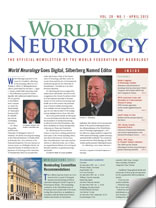More than 50 years ago, the World Federation of Neurology (WFN) was established to facilitate dialogue in neuroscience research. With the advent of enhanced travel, communication and, in particular, the Internet, neuroscience research has come to exist independently on the world stage and is self-sustaining. Neurology education, on the other hand, though to some extent supported by the same phenomena, is not globally self-sustaining.
Education methodology is constantly under review and differs substantially throughout the world. Though partly a function of those delivering education and of those being educated, there is, of course, much more to education than those variables alone. We believe that there is no better crucible to test neurology education than the world stage with all of its diversity.
The WFN Education Committee attempts to meet many of these diverse needs. Our strength is a function of the breadth of ideas defining our infrastructure, and the coalitions we form, to facilitate development and spreading of our activities.
We encourage our committee and neurologists in all of our member countries to come together for education.
Three years ago when we assumed the leadership of this committee, we recognized the need for enhanced staff support, and the WFN trustees responded to our request. We understood that our reputation for fairness, transparency and quality was essential, and therefore set about defining standard operating procedures (SOPs). We recognized, of course, that substantial variability in their application would be necessary, given the lack of homogeneity in our membership. For example, accrediting a teaching center in a remote region of Peru would be vastly different from endorsing a subspecialty training program in Melbourne, Australia. Both have been accomplished recently.
Our infrastructure is all but in place. The last vital element, the breadth and depth of the ideas we work with, remains to be built. There are 25 members of the WFN Education Committee and to date there has been minimal opportunity for exchange of ideas. The expansion of the WFN website and in particular the restricted area for committee members, to allow rapid exchange of ideas, is now in place.

Dr. Wolfgang Grisold, Professor Ferdusi, Dr. Steve Sergay and Dr. Federico Pelli-Noble at Trujillo University, Peru.
We are attempting to encourage our committee and neurologists in all of our member countries to come together for education, by making available on the website our SOPs and pictures of the success of some of our programs. We will grow in our ability and our reach by your input. We look forward to your feedback. We hope that the WFN Education Committee efforts during the American Academy of Neurology meeting on March 17 at the Marriott Marquis and Marina in San Diego offered a springboard for development of even more ideas.
We welcome the roll-out of this new electronic version of World Neurology, its new editor Don Silberberg and his editorial board. We look forward to the renewed growth of World Neurology and this method of revealing the education opportunities available for all members of the WFN.

